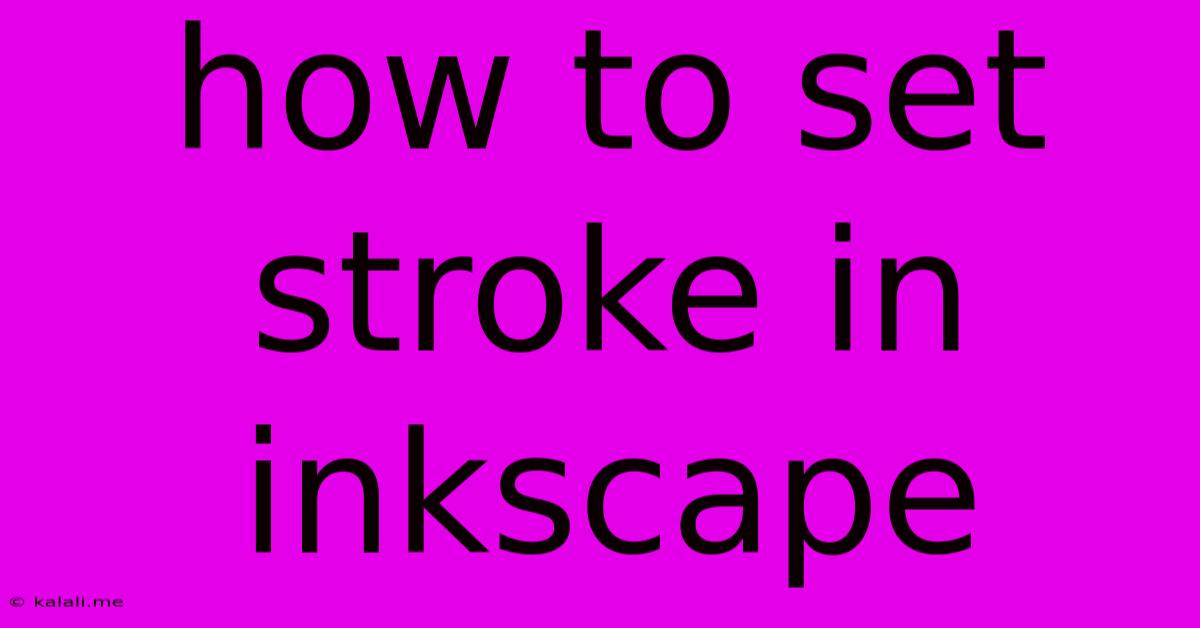How To Set Stroke In Inkscape
Kalali
Jun 04, 2025 · 3 min read

Table of Contents
How to Set Stroke in Inkscape: A Comprehensive Guide
Setting the stroke in Inkscape is crucial for creating visually appealing and professional-looking vector graphics. This comprehensive guide will walk you through various aspects of stroke customization, from basic adjustments to advanced techniques. Whether you're a beginner or an experienced user, you'll find valuable tips and tricks here to master stroke manipulation in Inkscape.
Understanding Strokes in Inkscape
In Inkscape, a stroke refers to the outline of a path or shape. Unlike fill, which colors the interior of a shape, the stroke defines its border. You can adjust various stroke properties to change its appearance, including width, color, style (dashed, dotted, etc.), and opacity. Mastering these adjustments is essential for creating diverse and detailed vector illustrations.
The Basic Stroke Settings
The most common stroke settings are easily accessed through the Stroke Paint panel in the right-hand toolbar. If you don't see it, go to Window > Stroke Paint. Here you'll find options to:
- Set Stroke Width: Use the numerical input field or the slider to adjust the thickness of the stroke. Experiment with different values to find what works best for your design.
- Choose Stroke Color: Click the color swatch to open the color picker and select your desired color. You can use hex codes, RGB values, or the color palette for precise color selection.
- Select Stroke Style: Inkscape provides a range of pre-set stroke styles, from solid lines to various dashed and dotted patterns. Experiment with these options to achieve a specific look for your design. This allows you to create unique patterns easily.
Beyond the Basics: Advanced Stroke Customization
Inkscape offers more advanced stroke customization options beyond the basic settings:
-
Adjusting Stroke Caps and Joins: The
Stroke stylepanel also lets you fine-tune how the stroke begins and ends (caps) and how it connects at corners (joins). Options include:- Cap: Round, Butt, and Square caps provide different visual effects at the stroke's ends.
- Join: Miter, Round, and Bevel joins control how corners are handled, influencing the overall shape. Experiment to see how these options change your stroke’s appearance, especially in sharp-edged designs.
-
Dash and Gap Customization: For dashed and dotted strokes, you can precisely control the length of the dashes and the gaps between them. This allows for creating highly customized line patterns.
-
Stroke Opacity: Control the transparency of your stroke using the opacity slider in the Stroke Paint panel. This is particularly useful for layering and creating subtle effects.
-
Using Multiple Strokes: While less common, you can even apply multiple strokes to a single object. Imagine a thick black stroke with a thinner white stroke on top – a technique used for highlighting or creating visual separation. This requires duplicating the object and adjusting the stroke settings on each copy.
Practical Applications and Examples
The ability to precisely control strokes is vital in many design scenarios:
- Creating Diagrams and Technical Drawings: Accurate stroke width and styles are essential for precise representation of technical details.
- Illustrating Characters and Objects: Varying stroke width can add depth and dimension to your illustrations. Thicker strokes can represent shadow or emphasis.
- Designing Logos and Branding: Carefully chosen stroke colors and styles can significantly impact the visual appeal of your brand identity.
- Creating Custom Patterns: Through the advanced settings of dashes and gaps, you can craft an extensive range of unique patterns.
Troubleshooting and Tips
- Stroke Not Appearing: Make sure you have actually selected a stroke color and that the stroke width isn't set to 0.
- Unexpected Stroke Behavior: Ensure that your object is not grouped with others in a way that affects the stroke settings.
By mastering these techniques, you can significantly improve the quality and visual impact of your Inkscape projects. Experimentation is key – try different combinations of stroke settings to explore the creative possibilities. Remember that practice makes perfect; the more you work with strokes, the more confident and creative you'll become.
Latest Posts
Latest Posts
-
What Is The Opposite Of An Acid
Jun 06, 2025
-
What Does Sudo Do In Discord
Jun 06, 2025
-
Receiving Mail For Someone Else At My Address
Jun 06, 2025
-
Logic Gate That Flips Its Input
Jun 06, 2025
-
Main Water Shutoff Valve From Well
Jun 06, 2025
Related Post
Thank you for visiting our website which covers about How To Set Stroke In Inkscape . We hope the information provided has been useful to you. Feel free to contact us if you have any questions or need further assistance. See you next time and don't miss to bookmark.